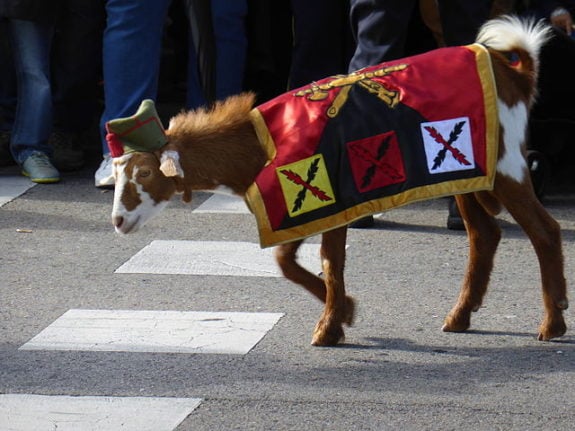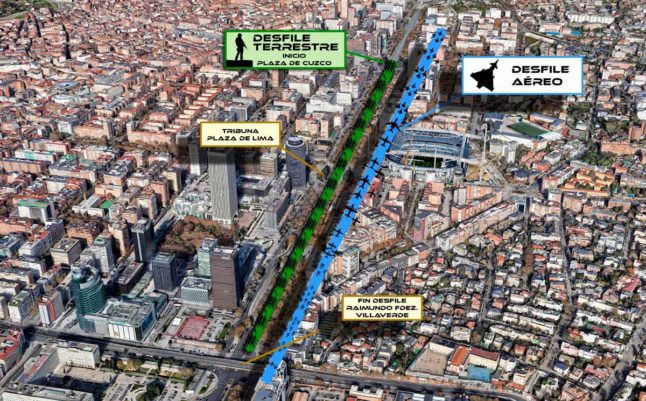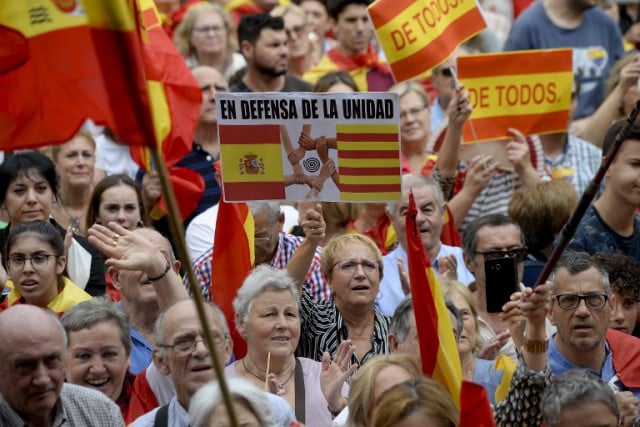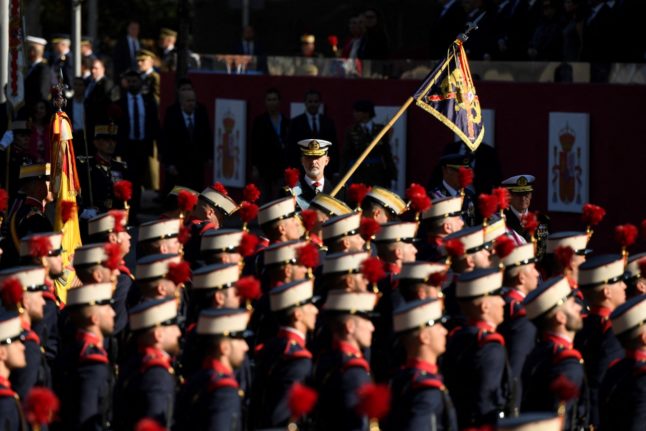How do people usually celebrate National Day in Spain?
The biggest event on National Day in Spain is a massive military parade along Madrid’s Paseo de la Castellana – it is also Armed Forces Day.
The army, navy, air force, Guardia Civil and even the Spanish Legionnaires – who even bring with them their goat mascot – come out in force to march along the capital’s grandest thoroughfare.
King Felipe VI, who is head of the armed forces, attends with Queen Letizia and their daughters, as well as the Prime Minister, leading politicians, and foreign dignitaries.
The culmination of the event is a fly-by from the Spanish Air Force acrobatics team, the Patrulla Águila, who release a stream of crimson and gold smoke to replicate Spain’s national flag across the sky.
Celebrations also usually take place in other parts of Spain. Málaga holds a military procession in its Parque Huelin. Huelva also hosts a big celebration, as does Zaragoza, where the cathedral is dedicated to Our Lady of the Pilar, the patron of the Spanish Guardia Civil and of the Hispanic world.
Many families, especially those connected to the military, will turn out to watch the parades, but for the most part people will see it as a day off and do what people do best on a holiday: sleep late, enjoy a long lunch or escape the cities for a long weekend.

What will happen on National Day in Spain in 2023?
This year’s National or Hispanic Day celebrations in Madrid will see the usual crowds gather along Madrid’s emblematic Paseo de la Castellana to watch the military parades and air shows, and perhaps even catch a glimpse of King Felipe and the Spanish royal family.

Some of Madrid’s top museums will also be free to the public on Thursday, including Museo Sorrolla, Reina Sofía, El Prado, Museo de América and the city’s archaeological and anthropological museums.
There will also be plenty of other events taking place across Madrid to mark the occasion, from concerts to street theatre and other performances.
You can expect a similar celebratory atmosphere across many of Spain’s big cities, from free entrance to emblematic buildings in Valencia to hot-air balloon trips in Seville. Here is a detailed breakdown of everything happening across Spain on Thursday October 12th.
As Spanish patriotic displays go, Spain’s National Day is as big as it gets.
However, not everybody is happy Spain’s Día de la Hispanidad (Hispanic Day) exists.
So why does Spain celebrate it? And why do some of its critics want it banned?
A bit of history
There may not be much mention of the explorer himself on the day, but the date October 12th commemorates the so-called ‘discovery’ of the Americas by Christopher Columbus (Cristóbal Colón in Spanish).
On that day in 1492 a Spanish expedition led by Columbus arrived to what today is known as San Salvador, in the Bahamas, and made the first step towards what would become the Spanish empire.

Spain conquered parts of present-day United States and most territories across South America.
Together with other territories that the Spanish realm had already conquered, it made el imperio español the greatest of its time.
Hispanic Day also commemorates the unification of the realms of Castilla and Aragón, which eventually became the Spain we know today, an event that happened earlier in 1492 after the Spanish army reconquered Granada, the last stronghold of the Moors in Europe.
El Día de la Hispanidad was first celebrated in Madrid in 1935 and was made an official public holiday in 1981.
In 1987, its name was changed to La Fiesta Nacional (Spain’s National Day), removing any reference to Spanish colonialism.
The controversy
There is a lot of controversy around this celebration in Spain, and no surprise to learn that the biggest criticism comes from Catalonia, the region where part of the population is pushing for independence.
READ ALSO: Catalans march for unity on Spain’s national day
While some Catalans opposed to breaking away from Spain rally to celebrate Spain’s National Day, others rally against it.
Some town halls and companies refuse to observe it as a holiday and instead changed the day off work to October 1st – La Diada, Catalonia’s National Day – when protests are also held to mark the anniversary of the 2017 referendum on independence declared unconstitutional by Madrid.
READ MORE: Badalona cancels Columbus holiday ‘glorifying genocide’
Some political parties in the Basque Country and Navarra also refuse to mark Hispanic Day. Basque nationalists are absent for the same reason as the Catalan separatists and in Navarra, the regional government replaced the Día de Hispanidad with the Day of Indigenous Peoples.
Members of far-left party Unidas Podemos have also previously strongly disagreed with the October 12th celebration, refusing over the years to take part in the official event, partly because it is led by the King, and they are a Republican party. They also argue that celebrating Columbus Day would mean celebrating the genocide that followed his discovery of “the new world”.
When ex-Podemos leader Pablo Iglesias became Deputy PM as part of his party’s governing coalition with the PSOE, he did however take part in the official event.
But in many Republicans’ minds the day still has strong associations with the Francoist era when the dictator used the celebration to display his military might and extol the values of the dictatorship.
And how about Latin Americans themselves, you may ask? Well, for years several countries on the continent whose indigenous ancestors were subdued, enslaved or killed by Spanish conquistadores have questioned whether this Hispanic heritage is worth celebrating.
Recent socialist governments have in many cases ditched the original name of the celebration, El Día de la Raza (The Day of Race, the Spanish race that is), coined by a Spanish minister in 1913.
In Argentina, Cristina Fernández de Kirchner changed it to ‘Day of Respect for Cultural Diversity’, Rafael Correa decreed that in Ecuador it would be renamed ‘Day of Interculturality and Plurinationality’. The governments of Daniel Ortega of Nicaragua and Hugo Chávez in Venezuela called it ‘Day of Indigenous Resistance’, Morales in Bolivia renamed it ‘Day of Decolonisation’ and in Peru they celebrate the ‘Day of Indigenous Peoples and Intercultural Dialogue’.
On the other hand, the United States still calls October 12th Columbus Day and other American nations have stuck by the original ‘Spanish race’ name.
Changing the narrative of Spanish colonisation to emphasise the struggle of the continent’s indigenous does seem to be the trend nonetheless.
But not all Spanish politicians agree with tainting Spain’s history. In late September 2022, following Pope Francis’s apology for the evangelisation “sins” committed by the Church during the conquista, Madrid’s regional leader Isabel Díaz Ayuso slammed the pontiff.
“It surprises me that a Catholic who speaks Spanish says this about a legacy like ours, after all our missions brought Spanish and Catholicism – and with them civilisation and freedom – to the American continent”.




 Please whitelist us to continue reading.
Please whitelist us to continue reading.